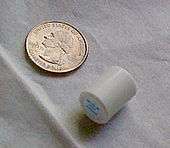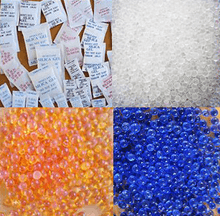Desiccant


A desiccant is a hygroscopic substance that induces or sustains a state of dryness (desiccation) in its vicinity. Commonly encountered pre-packaged desiccants are solids that adsorb water. Desiccants for specialized purposes may be in forms other than solid, and may work through other principles, such as chemical bonding of water molecules. They are commonly encountered in foods to retain crispness. Industrially, desiccants are widely used to control the level of water in gas streams.
Types of desiccants
Although some desiccants are chemically inert, many are extremely reactive and require specialized handling techniques. The most common desiccant is silica, an otherwise inert, nontoxic, water-insoluble white solid. Tens of thousands of tons are produced annually for this purpose.[1] Other common desiccants include activated charcoal, calcium sulfate (Drierite),[2] calcium chloride, and molecular sieves (typically, zeolites).
Performance efficiency
One measure of desiccant efficiency is the ratio (or percentage) of water storable in the desiccant relative to the mass of desiccant.
Another measure is the residual relative humidity of the air or other fluid being dried.
The performance of any desiccant varies with temperature and both relative humidity and absolute humidity. To some extent, desiccant performance can be precisely described, but most commonly, the final choice of which desiccant best suits a given situation, how much of it to use, and in what form, is made based on testing and practical experience.
Coloured saturation indicators

Sometimes a humidity indicator is included in the desiccant to show, by color changes, the degree of water-saturation of the desiccant. One commonly used indicator is cobalt chloride (CoCl2). Anhydrous cobalt chloride is blue. When it bonds with two water molecules, (CoCl2•2H2O), it turns purple. Further hydration results in the pink hexaaquacobalt(II) chloride complex [Co(H2O)6]Cl2.
Applications
One example of desiccant usage is in the manufacture of insulated windows where zeolite spheroids fill a rectangular spacer tube at the perimeter of the panes of glass. The desiccant helps to prevent the condensation of moisture between the panes. Another use of zeolites is in the dryer component of air conditioning systems to help maintain the efficacy of the refrigerant. Desiccants are also commonly used to protect goods in shipping containers against moisture damage. Hygroscopic cargo, such as cocoa, coffee, and various nuts and grains, are particularly susceptible to mold and rot when exposed to condensation and humidity. Because of this, shippers often take precautionary measures to protect against cargo loss.
Desiccants induce dryness in any environment and reduce the amount of moisture present in air. Desiccants come in various forms and have found widespread use in the food, pharmaceuticals, packing, electronics and many manufacturing industries.
Air conditioning systems can be made based on desiccants.[3]
Drying of solvents

Desiccants are also used to remove water from solvents, typically required by chemical reactions that do not tolerate water, e.g., the Grignard reaction. The method generally, though not always, involves mixing the solvent with the solid desiccant. The dried solvent is then separated from the desiccant by filtration or distillation.[4][5]
See also
- Desiccator
- Humidity buffering
- Humidity indicator card
- Hygroscopy
- Moisture sorption isotherm
- Solar air conditioning
- Sorbent
References
- ↑ Otto W. Flörke, et al. "Silica" in Ullmann's Encyclopedia of Industrial Chemistry, 2008, Weinheim: Wiley-VCH, . doi:10.1002/14356007.a23_583.pub3.
- ↑ http://www.drierite.com
- ↑ Daou, K; Wang, Xia (2005). "Desiccant cooling air conditioning: a review". Renewable and Sustainable Energy Reviews 10 (2): 55–77. doi:10.1016/j.rser.2004.09.010.
- ↑ Chai, Christina Li Lin; Armarego, W. L. F. (2003). Purification of laboratory chemicals. Oxford: Butterworth-Heinemann. ISBN 0-7506-7571-3.
- ↑ Williams, D. B. G., Lawton, M., "Drying of Organic Solvents: Quantitative Evaluation of the Efficiency of Several Desiccants", The Journal of Organic Chemistry 2010, vol. 75, 8351. doi: 10.1021/jo101589h
Further reading
- Lavan, Z.; Jean-Baptiste Monnier, Worek, W. M. (1982). "Second Law Analysis of Desiccant Cooling Systems". Journal of Solar Energy Engineering 104 (3): 229–236. doi:10.1115/1.3266307.
- S. Sadik; J. W. White (1982). "True potato seed drying over rice". Potato Research 25 (3): 269. doi:10.1007/BF02357312.
External links
- Drierite Desiccants
- Desiccant Requirement Chart (printable)
- A Desiccant Requirements Calculator
- Information on Desiccant Dryers
- Moisture In Electronics